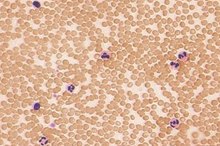Relationship Between Lymphocytes & Nutrition
Your immune system forms a barrier against infectious disease. Lymphocytes, a class of white blood cells, play a key role in recognizing and fighting harmful pathogens. B-cell lymphocytes produce antibodies, a type of protein that attaches to pathogens and marks them for destruction, and T-cell lymphocytes engulf and destroy the pathogen. Several factors affect the health of your lymphocytes, but a diet rich in essential nutrients helps them function.
Vitamin A
Vitamin plays a key role in lyphocyte function. Retinoic acid -- one form of vitamin -- guides the development of bone marrow stem cells into mature lymphocytes. Vitamin A also activates T-cell lymphocytes so they can fight off infection, while a deficiency in vitamin A prevents proper lymphocyte function. Just adding a handful of leafy greens or a serving of orange veggies to your diet each day helps you get the recommended 2,333 IU of vitamin A for women and 3,000 IU for men. A single half-cup serving of sweet potato or pumpkin boasts more than 3,000 IU of vitamin A, while a cup of carrots boasts roughly 3,200 IU. Spinach and kale also come packed with vitamin A -- a half-cup of cooked greens contains 1,572 and 1,475 IU, respectively.
- Vitamin plays a key role in lyphocyte function.
- Spinach and kale also come packed with vitamin A -- a half-cup of cooked greens contains 1,572 and 1,475 IU, respectively.
Vitamin B-6
Foods That Increase White Blood Cells
Learn More
Getting enough B-6 in your diet helps lymphocytes mature, while a deficiency prevents growing white blood cells from turning into active T- and B-cell lymphocytes. Vitamin B-6 deficiency also decreases the production of a protein, call interleukin-2, that your lymphocytes need to function. Your diet should provide 1.3 milligrams of vitamin B-6 daily. A 6-ounce portion of salmon provides roughly three-quarters of this intake goal, while a 4-ounce serving of turkey or chicken contains 40 and 78 percent of your recommended daily intake, respectively. For vegetarian-friendly sources of vitamin B-6, reach for bananas, spinach and hazelnuts.
- Getting enough B-6 in your diet helps lymphocytes mature, while a deficiency prevents growing white blood cells from turning into active T- and B-cell lymphocytes.
Zinc
Zinc activates hundreds of proteins in your body -- including a hormone called thymulin that's essential for T-cell lymphocyte function. It also helps your lymphocytes develop properly. You only need a small amount of zinc daily for immune function -- 11 milligrams for men and 8 milligrams for women. A single serving of six, medium-cooked oysters contains more than the amount of zinc you need each day, while a 3-ounce serving of beef and crab contain up to 5.8 and 4.7 milligrams of zinc, respectively. Peanuts and almonds each contain 0.9 milligram of zinc per ounce, an ounce of cashews provides 1.6 milligrams and a half-cup of chickpeas contains up to 1.3 milligrams of zinc.
- Zinc activates hundreds of proteins in your body -- including a hormone called thymulin that's essential for T-cell lymphocyte function.
- A single serving of six, medium-cooked oysters contains more than the amount of zinc you need each day, while a 3-ounce serving of beef and crab contain up to 5.8 and 4.7 milligrams of zinc, respectively.
Protein
The Nutrition in Lupine Seeds
Learn More
While zinc and vitamins A and B-6 play particularly important roles in lymphocyte heath, other nutrients prove important for their function, as well. Getting enough protein in your diet helps your lymphocytes function, while a diet low in protein reduces your lymphocyte cell count and hinders the formation of antibodies, which in turn negatively affects lymphocyte function.
Your protein intake needs depend on your activity level and weight. Average adults should multiply their weight, in pounds, by 0.4 to determine how many grams of protein they need each day. Endurance athletes should multiply their weight by 0.6 to determine their protein needs, while strength trainers should multiply by 0.8, recommends the Iowa State University Extension. Use a combination of healthy protein sources -- such as poultry, fish, nuts, beans, eggs and dairy -- to reach your intake goal.
- While zinc and vitamins A and B-6 play particularly important roles in lymphocyte heath, other nutrients prove important for their function, as well.
- Average adults should multiply their weight, in pounds, by 0.4 to determine how many grams of protein they need each day.
Related Articles
References
- Springfield Technical Community College: Lymphocytes
- Linus Pauling Institute: Vitamin A
- Linus Pauling Institute: Vitamin B-6
- Linus Pauling Institute: Zinc
- Lumen Boundless Microbiology. Phagocytes.
- Chemocare. The immune system: information about lymphocytes, dendritic cells, macrophages, and white blood cells.
- Immunity. Understanding subset diversity in T cell memory. Updated February 20, 2018.
- National Cancer Institute. CAR T cells: engineering patients' immune cells to treat their cancers. Updated July 30, 2019.
- Encyclopaedia Britannica. Antibody. Updated May 7, 2019.
- Encyclopaedia Britannica. Lymphocyte. Updated December 15, 2017.
- Jabri B, Sollid LM. T cells in celiac disease. J Immunol. 2017;198(8):3005-3014. DOI:10.4049/jimmunol.1601693
- Dana-Farber Cancer Institute. Non-Hodgkin lymphoma and Hodgkin lymphoma: what's the difference? Updated November 6, 2019.
- Cruz-Adalia A et al. T cells kill bacteria captured by transinfection from dendritic cells and confer protection in mice. Cell Host & Microbe. 2014 May 14;15(5):611-22.
- Sharpe M et al. Genetically modified T cells in cancer therapy: opportunities and challenges. Disease Models & Mechanisms. 2015 Apr;8(4):337-50.
- U.S. Library of Medicine. Lymphocytes fact sheet.
Writer Bio
Sylvie Tremblay holds a Master of Science in molecular and cellular biology and has years of experience as a cancer researcher and neuroscientist. Based in Ontario, Canada, Tremblay is an experienced journalist and blogger specializing in nutrition, fitness, lifestyle, health and biotechnology, as well as real estate, agriculture and clean tech.









